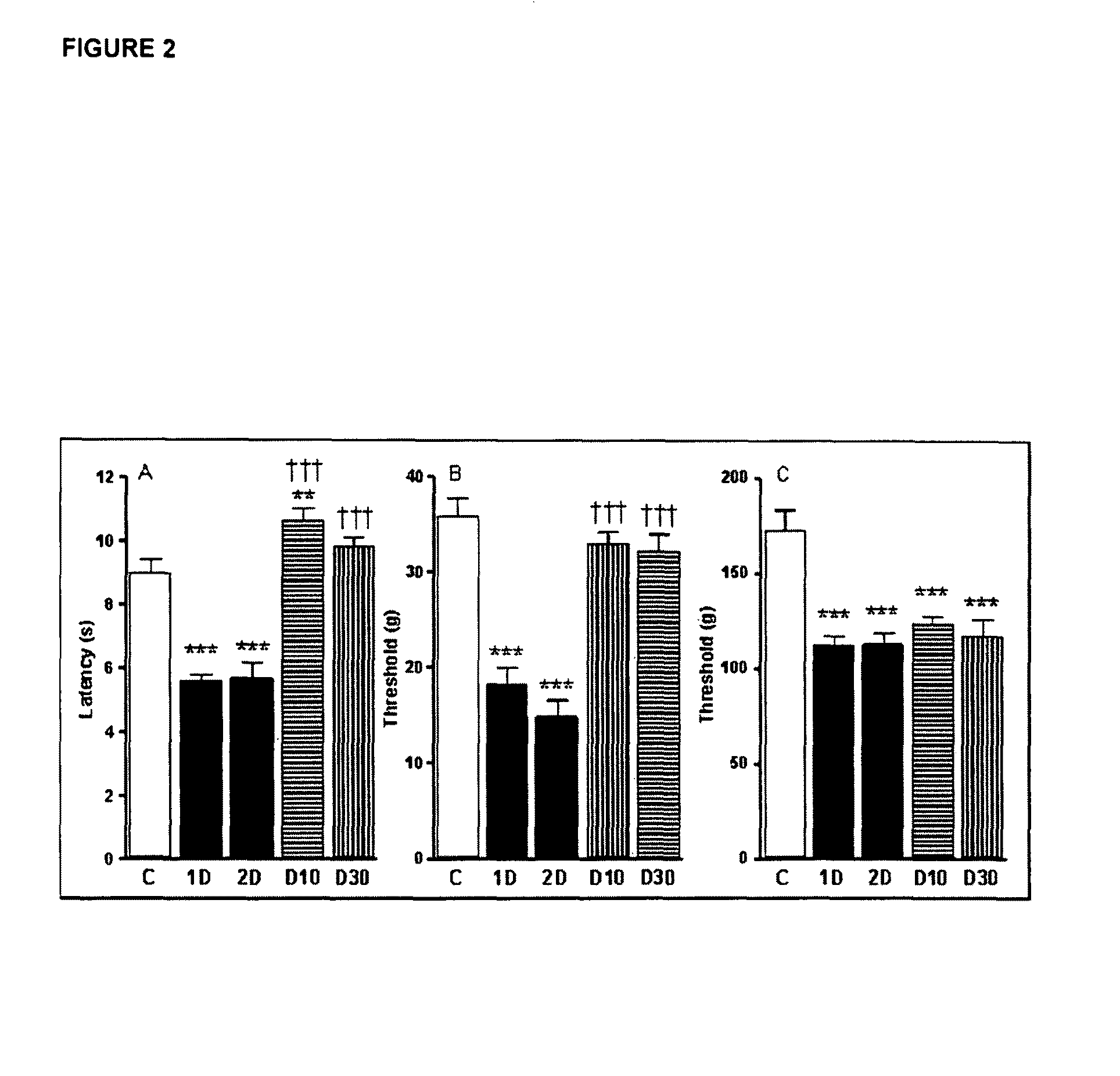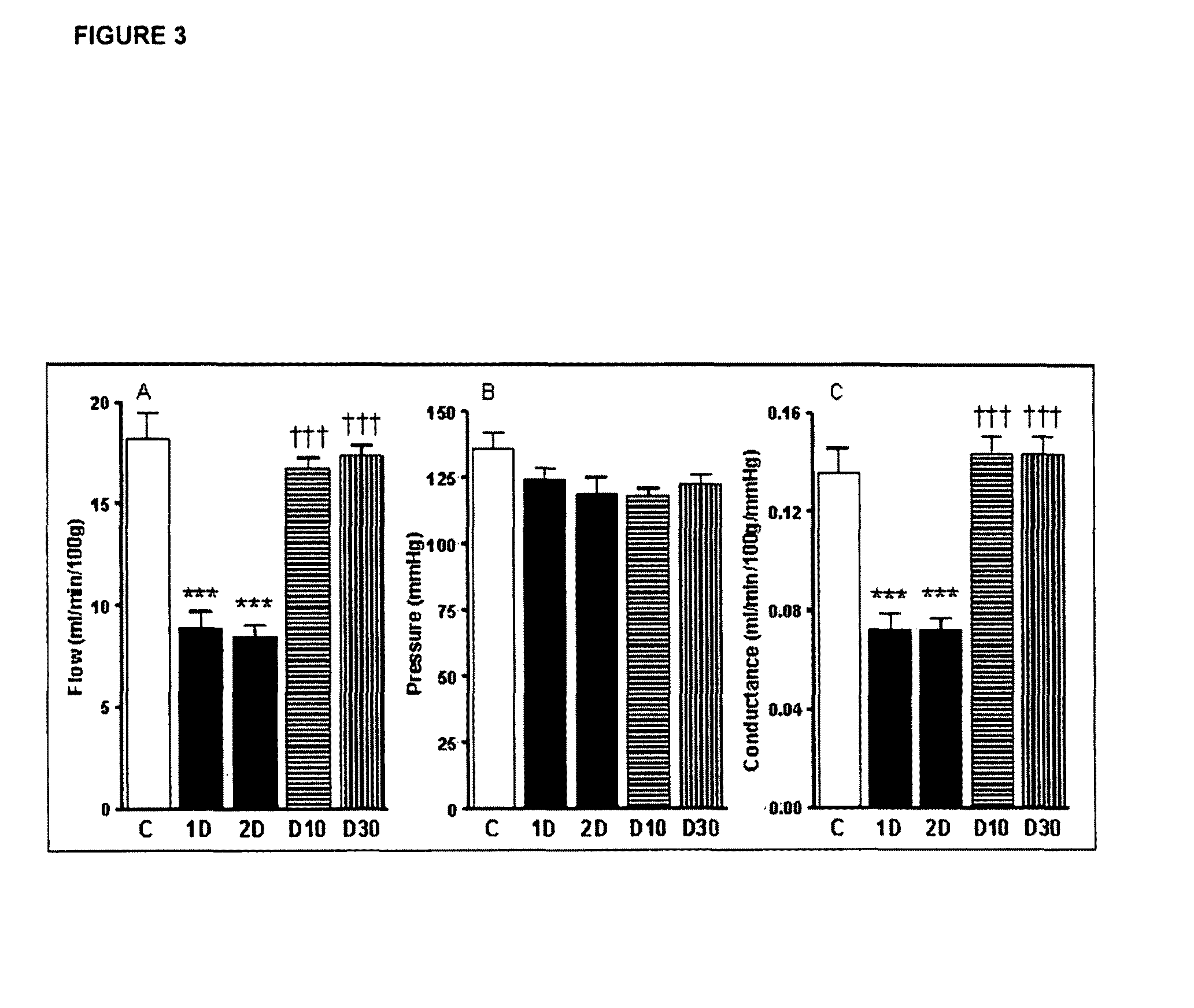Method for inhibiting a microvascular complication by administering IL-6
a microvascular and complication technology, applied in the field of microvascular complications, can solve the problems of mild hyperglycemia, frequent onset of hypoglycemia, and further impairment of glucose toleran
- Summary
- Abstract
- Description
- Claims
- Application Information
AI Technical Summary
Problems solved by technology
Method used
Image
Examples
example 1
Effect of IL-6 in Motor and Sensor Deficits in Experimental Diabetes
[0149]The aim of the following experiments was to examine whether IL-6 treatment could correct existing abnormalities in large myelinated and small nerve fiber populations in the streptozotocin-diabetic rat model of diabetic neuropathy.
[0150]Experimental Set-Up: Diabetic Rat Model and IL-6 Administration Regimen.
[0151]Diabetes was induced in mature (19 week old) male Sprague-Dawley rats by a single intraperitoneal (i.p.) injection of streptozotocin (40-45 mg / kg). After 4 weeks without treatment, during which nerve conduction velocity (NCV) and blood flow deficits develop and stabilize [Cameron 1991], diabetic rats were given 4 weeks treatment with IL-6 at 2 doses of 10 mcg / kg and 30 mcg / kg, respectively, sub-cutaneously, and 3-times per week.
[0152]Before the start of IL-6 treatment and at the end of the treatment period, tactile allodynia (pain resulting from a non-noxious stimulus to normal skin) and mechanical sti...
example 2
Beneficial Effect of IL-6 in Microvascular Complications
[0167]There is indirect evidence that diabetic neuropathy results from hypoxia and reduced blood flow (Cameron 2001). In the animal model illustrated in Example 1, there is shown impairment in neural performance in a model of diabetes. In Example 1. It is also shown that neural performance is corrected by IL-6.
[0168]The following experiments were carried out to directly asses whether neuropathy in the diabetes model of example 1 mimics the human disease in terms of neural blood flow defficiency, and whether the beneficial effects of IL-6 in this model is due to correction of neural blood flow.
[0169]Thus, the blood flow in endoneural tissue and the changes in systemic blood pressure were measured in non treated rats versus diabetic rats, and in diabetic rats treated with IL-6.
[0170]The rats of Example 1 were anaesthetized with thiobutabarbital (50-100 mcg / kg i.p.) and the carotid artery and trachea (macrovasculature) were cannul...
example 3
Production of IL-6 an IL-6R / IL-6 in CHO Cells
[0177]The cDNA sequence encoding for the soluble IL-6 receptor (natural form of sIL-6R found in urine, Oh et al., 1997) is fused with that encoding for mature IL-6. Sequences for 3 bridging amino acids (EFM) were also present. The fused gene is inserted in an expression vector under the control of CMV promoter and introduced into CHO cells. A production process is developed and the resulting recombinant protein is purified by immunopurification using an anti-IL-6R monoclonal antibody. FIG. 4 schematically shows the composition of the IL-6R / IL-6. The mature protein comprises 524 amino acids. A protein produced and purified as outlined above is suitable to be administered according to the invention.
[0178]Recombinant human IL-6 (r-hIL-6) was produced in genetically engineered Chinese Hamster Ovary (CHO) cells. The production process begun with the growth and expansion of cells from a working cell bank (WCB) and continued under conditions whe...
PUM
| Property | Measurement | Unit |
|---|---|---|
| concentrations | aaaaa | aaaaa |
| concentrations | aaaaa | aaaaa |
| internal diameter | aaaaa | aaaaa |
Abstract
Description
Claims
Application Information
 Login to View More
Login to View More - R&D
- Intellectual Property
- Life Sciences
- Materials
- Tech Scout
- Unparalleled Data Quality
- Higher Quality Content
- 60% Fewer Hallucinations
Browse by: Latest US Patents, China's latest patents, Technical Efficacy Thesaurus, Application Domain, Technology Topic, Popular Technical Reports.
© 2025 PatSnap. All rights reserved.Legal|Privacy policy|Modern Slavery Act Transparency Statement|Sitemap|About US| Contact US: help@patsnap.com



